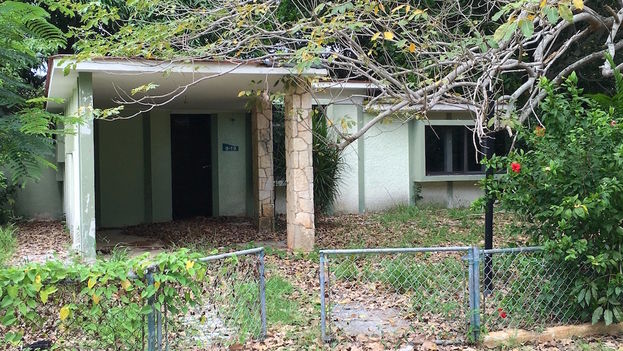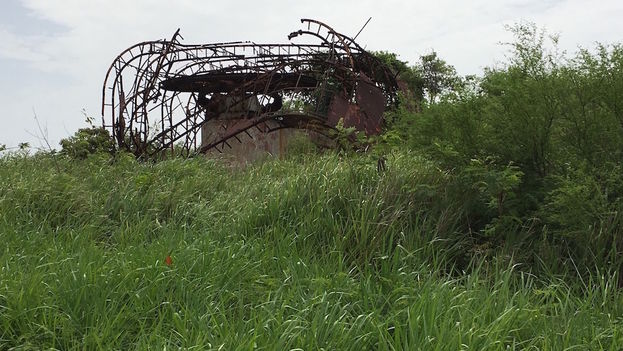
![]() 14ymedio, Luz Escobar, Havana, 17 September 2016 – “This was my house,” says Elena, a Cuban-American who returned to the island this week and visited the place where she spent her childhood. In Tarará she took her fist steps, but the place barely resembles the residential neighborhood of her memories. In five decades it has passed from being an enclave of rich people to hosting a teacher’s training school, a Pioneers camp for schoolchildren, a sanatorium for children affected by radioactivity, and a tourist’s villa.
14ymedio, Luz Escobar, Havana, 17 September 2016 – “This was my house,” says Elena, a Cuban-American who returned to the island this week and visited the place where she spent her childhood. In Tarará she took her fist steps, but the place barely resembles the residential neighborhood of her memories. In five decades it has passed from being an enclave of rich people to hosting a teacher’s training school, a Pioneers camp for schoolchildren, a sanatorium for children affected by radioactivity, and a tourist’s villa.
In the town, located east of Havana in a beautiful coastal area, the city’s crème de la crème settled in the middle of the last century. None of the residents of the 525 houses of this little paradise could imagine that soon after the titles of their homes were released, only 17 families would remain there and the rest would emigrate or lose their property after Fidel Castro’s coming to power.
“My father bought the parcel with great enthusiasm, he always said that he would live his last years here,” recalls Elena now. She walks around the house that has lost all the wood of its doors and windows. Weeds have taken over the terrace area and on the floor of the main hall there is evidence of the many bats that sleep in the room every night.
A man sweeping the street asks the newcomer if she passed through “the entry gate” control where visitors must pay for access to Tarará. For five convertible pesos Elena has returned to the place of her nostalgia, with “lunch included” in a solitary cafe by the sea.
She heads in that direction, but not before crossing herself before the lonely church dedicated to Santa Elena, which had gotten its cross back a few years earlier, after its having been removed during the decades when the most rabid atheism ruled the place. “They baptized my littlest sister here,” recalls the woman in front of the chapel.
In the bar of the local restaurant the waiter tells her that during elementary school he spent several weeks in Tarará. Although they swap stories about the same piece of Cuban earth, they seem to be talking about opposite poles. “I liked coming because they gave us yogurt at breakfast and lunch, and in one of the houses I saw a bathtub for the first time,” explained the man who is now over 40.
His memories correspond to the days when the once glamorous villa had been converted into the José Martí Pioneers City. The camp hosted thousands of school age children every year, “they were like vacations except we had to go to school,” explained the man.
The Soviet subsidy supported the enormous complex which included a cultural center, seven dining rooms, five teaching wings, a hospital, an amusement park and even an attractive cable car crossing between the two hills over the Tarará River, which is now a mass of rusted iron.

Elena, meanwhile, recalls the backyard fruit trees, the squash court, and the softball field that filled with families on the weekends. However, her fondest memories relate to the drive-in theater located at the entrance to the village, which is now converted into a parking lot. Between her memories and the waiter’s are 30 years, and a social revolution.
“Now the only people who can enter are those with reservations in the few houses rented to tourists in this neighborhood,” explains the employee. They belong to the families who resisted leaving despite all the pressure they received. “Overnight the village filled with young people who came to the countryside to study dressmaking,” he explains.
The few residents who didn’t leave “went through hell” the sweeper says. “They had to travel miles to find a store and all around the houses were places for dancing and checkpoints,” he recalls.
A few years ago the state-owned tourist corporation Cubanacan rehabilitated 274 houses and another state-owned entity, Cubalse, did another 223. However, the projected tourist center hasn’t taken off. “This place lost its soul,” commented the sweeper while gathering up leaves from a yagruma tree that have fallen on the sidewalk. The plaque marking the pier where Ernst Hemingway docked his yacht can barely be discerned in the midst of the undergrowth.
In the nineties, Tarará was the epicenter of a program sponsored by the Ministry of Public Health for children affected by the Chernobyl nuclear accident. They came from Moldovia, Belaruss and Ukraine, shortly after the economic crisis – sparked by the loss of the Soviet subsidy after the breakup of the Soviet Union – had put an end to the Pioneers camp.
The official press explained, at the time, that Cuba’s children had donated their “palace” to those affected by the tragedy, but no one remembers a single meeting at the school announcing the transformation the villa would undergo.
Early in this century 32,048 patients from Central and South America and the Caribbean passed through Tarará in the noted Operation Miracle, funded by Venezuelan oil. They came with different eye diseases such as cataracts and retinitis pigmentosa. They found a haven of peace in the place where only Cuban personnel working with patients and the few remaining residents were allowed to enter.
A decade ago 3,000 Chinese students came in turn to study Spanish and a police school was established in the neighborhood; its classrooms are often used to hold members of the Ladies in White when they are arrested on Sunday after leaving Mass at Santa Rita Church, on the other side of the city.
“This looks like a ghost town,” says Elena loudly as she walks the streets. Successive “programs of the Revolution” that filled the neighborhood have ended and now all that’s left is a development of numerous abandoned houses and others were a few tourists take the sun on the terraces. The beach where the visiting Cuban-American found her first snails is still there “as pretty as ever,” she says.
